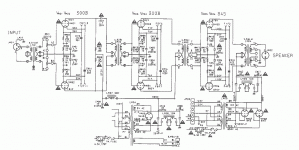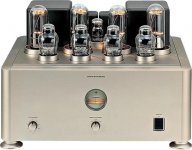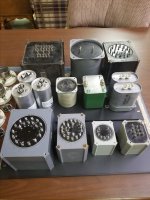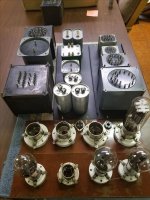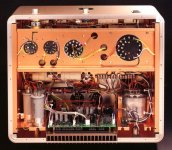For a while I've struggled to understand why the guys who designed the T1
went with 300B as a preamp tube?? Amplification factor of 3.9
Seems like there are much better tubes out there other than the 300B for preamplification.
Look at the 5687 http://bit.ly/2VL3GY4 Amp factor of 17 with a low 3K ohm plate resistance. 5687 rocks when compared with tubes like 5692, 6SN7, 7N7, it's a power house medium mu twin triode.
But the designer guys went with four 300Bs?
Would a better front end not be 5687 in the front to get some decent gain and yeah maybe 300B driving the 845s?
Or 6SN7 driving a 5687 driving the 845s?
Is there an advantage of using four 300Bs? Or is it all for show?
Thoughts here please
went with 300B as a preamp tube?? Amplification factor of 3.9
Seems like there are much better tubes out there other than the 300B for preamplification.
Look at the 5687 http://bit.ly/2VL3GY4 Amp factor of 17 with a low 3K ohm plate resistance. 5687 rocks when compared with tubes like 5692, 6SN7, 7N7, it's a power house medium mu twin triode.
But the designer guys went with four 300Bs?
Would a better front end not be 5687 in the front to get some decent gain and yeah maybe 300B driving the 845s?
Or 6SN7 driving a 5687 driving the 845s?
Is there an advantage of using four 300Bs? Or is it all for show?
Thoughts here please
Attachments
Last edited:
I think at the time of that amp design, the Marantz name was taken over by a company in Japan.
Using DHT power tubes in early stages of amplifiers was commonly done by Sakuma-San.
Go look at his designs. 300B, 211, 845, etc.
This Marantz amp is truly a Boutique product.
Sometimes things are done because they can be done that way.
I bet it sounds pretty good.
Has anybody seen one, let alone heard one?
Using DHT power tubes in early stages of amplifiers was commonly done by Sakuma-San.
Go look at his designs. 300B, 211, 845, etc.
This Marantz amp is truly a Boutique product.
Sometimes things are done because they can be done that way.
I bet it sounds pretty good.
Has anybody seen one, let alone heard one?
Last edited:
Did you see the 980V with a pair of 845 as rectifiersThoughts here please
With the grid connected to the anode you get almost 2kV between grid and cathode
Mona
Has anybody seen one, let alone heard one?
It must be the most talked about amp no one has ever heard
If it was a marketing exercise, it was just brilliant. Or perhaps someone at a senior level just wanted a cool amp for his home. And with all UTC iron.
Well back in 1936 transformer coupled amplifiers were all the rage. Not that I'm against mind you. In fact to some degree I'll admit I like it. It makes your amp heavy as hell.
And the UTC boys were pushing their iron pretty vigorously. There is a least one circuit from a 1936 UTC catalog that is pretty damn close to the T1. Although they were using triode strapped 57s & 59s NOT 300Bs
Also, why no NFB ???
Oh yeah the 845 rectifiers give it that Western Electric look. But here again that's a lot of effort for eye candy.
And the UTC boys were pushing their iron pretty vigorously. There is a least one circuit from a 1936 UTC catalog that is pretty damn close to the T1. Although they were using triode strapped 57s & 59s NOT 300Bs
Also, why no NFB ???
Oh yeah the 845 rectifiers give it that Western Electric look. But here again that's a lot of effort for eye candy.
ArcheusLedoux,
This "Marantz" amp was designed in the 1990s. As I said, look up Sakuma-San in Japan, he has lots of transformer coupled amps, and power tubes for the preamp and input stages. Very popular in Japan. I heard several of his amps at VSAC 2003? in Silverdale, Washington . . . he was the featured guest there. (VSAC = Vacuum tube State of the Art Conference).
The Marantz is characterized by individual self bias resistors and bypass caps for all 6 tubes. Each 2 tube stage is Balanced.
Few people look at Balanced Transformer Coupled as having Intrinsic Negative feedback. It is applied by the coupling of the 2 halves of the primary windings. Here is how:
Triodes have dominant 2nd order harmonic. It pulls down harder in one direction, than it lessens current in the other signal direction. Suppose the Pull-tube plate pulls down way to hard. That reduces (lowers) its plate voltage too much. That in turn couples through the other half of the primary winding that is in opposite phase. That translates to a higher voltage to the Push-tube plate. The Push-tube plate is being told to go toward turn off by its grid, but the higher plate voltage makes it turn on harder. That extra current in the Push phase, counteracts the too-large current in the Pull phase. The same effect works when the signal goes the other direction.
Balanced transformer coupled and traditional Push Pull output stages both do this . . . Plate to Plate Negative Feedback. Did you ever think of it this way?
You are welcome to try to apply global negative feedback from output to input of that Marantz amp . . . through 4 transformers and 3 stages. But before you do, be sure to check the gain/phase curves of that topology.
Oh, I believe 845 tubes were invented by RCA in 1933. See if you can find a reference in Western Electric to an 845 prior to 1934.
If you want a Western Electric look, try using Western Electric 212E tubes. My friend built SE 212E amps, I saw the lighted room from the Thoriated filaments, heard the glorious sound on Spica 50 speakers, and was hooked. I love the 845, but the WE 212E makes the 845 look like a preamp tube. That 212E experience caused me to start my voyage back to tube amplifiers.
This "Marantz" amp was designed in the 1990s. As I said, look up Sakuma-San in Japan, he has lots of transformer coupled amps, and power tubes for the preamp and input stages. Very popular in Japan. I heard several of his amps at VSAC 2003? in Silverdale, Washington . . . he was the featured guest there. (VSAC = Vacuum tube State of the Art Conference).
The Marantz is characterized by individual self bias resistors and bypass caps for all 6 tubes. Each 2 tube stage is Balanced.
Few people look at Balanced Transformer Coupled as having Intrinsic Negative feedback. It is applied by the coupling of the 2 halves of the primary windings. Here is how:
Triodes have dominant 2nd order harmonic. It pulls down harder in one direction, than it lessens current in the other signal direction. Suppose the Pull-tube plate pulls down way to hard. That reduces (lowers) its plate voltage too much. That in turn couples through the other half of the primary winding that is in opposite phase. That translates to a higher voltage to the Push-tube plate. The Push-tube plate is being told to go toward turn off by its grid, but the higher plate voltage makes it turn on harder. That extra current in the Push phase, counteracts the too-large current in the Pull phase. The same effect works when the signal goes the other direction.
Balanced transformer coupled and traditional Push Pull output stages both do this . . . Plate to Plate Negative Feedback. Did you ever think of it this way?
You are welcome to try to apply global negative feedback from output to input of that Marantz amp . . . through 4 transformers and 3 stages. But before you do, be sure to check the gain/phase curves of that topology.
Oh, I believe 845 tubes were invented by RCA in 1933. See if you can find a reference in Western Electric to an 845 prior to 1934.
If you want a Western Electric look, try using Western Electric 212E tubes. My friend built SE 212E amps, I saw the lighted room from the Thoriated filaments, heard the glorious sound on Spica 50 speakers, and was hooked. I love the 845, but the WE 212E makes the 845 look like a preamp tube. That 212E experience caused me to start my voyage back to tube amplifiers.
Last edited:
The 300B is pretty good as a driver for a 845.
The rest of the circuit is something I often feel I'd like to try for the fun of it but then don't because I lack funds/parts and time and space and already have amplifiers around that have been named "that ridiculous machine".
The rest of the circuit is something I often feel I'd like to try for the fun of it but then don't because I lack funds/parts and time and space and already have amplifiers around that have been named "that ridiculous machine".
For a while I've struggled to understand why the guys who designed the T1
went with 300B as a preamp tube?? Amplification factor of 3.9
Seems like there are much better tubes out there other than the 300B for preamplification.
Look at the 5687 http://bit.ly/2VL3GY4 Amp factor of 17 with a low 3K ohm plate resistance. 5687 rocks when compared with tubes like 5692, 6SN7, 7N7, it's a power house medium mu twin triode.
But the designer guys went with four 300Bs?
Would a better front end not be 5687 in the front to get some decent gain and yeah maybe 300B driving the 845s?
Or 6SN7 driving a 5687 driving the 845s?
The Marantz T1 was a sort flagship made to show off what they could do. So it's pretty obvious that a tube that was not even designed for audio has no place in it.
Anyway for substantial voltage output the 6SN7 is generally more linear than the 5687. Has either lower distortion or less odd harmonics (or both). Odd harmonics will not go away even in a pure class A PP stage and one doesn't want that at the input stage. The 5687 is excellent as a cathode follower or good for less demanding applications. This is not a standard amplifier. How many have seen around?
The 300B driver (second stage) has less than 4x gain and the input stage has to provide at least 65V grid-to-grid clean drive.
The problem with the 6SN7 is its higher plate resistance but it's not impossible to use it with modern high permeability core materials and bifilar windings to get huge bandwidth.
Even worse if you ask the 5687 to drive the 845. It is possible but it's not comparable to a 300B. This is certain.
The overall gain is fine as it has a step-up input transformer to match its source. In this respect the 5687 or the 6SN7 would not give any benefit.
It's not only for the show although that was of primary importance. At the time it made sense because the tube amps were coming back really strong. So it was a sort of statement by a historical brand.Is there an advantage of using four 300Bs? Or is it all for show?
As said above the advantage is lower distortion at all levels. There is no other way in this case because it's impossible to use ground feedback with 4 transformers in cascade. Usually it's already a challenge with 2 and often not possible. Anyway using feedback at the time would have been seen as "cheating". Kind of shortcut to hide design flaws or weaknesses.......
Having said this I would never build this amp with that parafeed interstage coupling for the first stage. Today proper interstage transformers are available and better.
Last edited:
First stage Parafeed ? I thought the LS10 went to each grid of the next stage.
Yes. It is the loading transformer of the first stage. The 300B's are fed by means of 15K resistors. With a less linear tube like the 5687 would not work so well and possibly a CCS would be needed. That would have spoiled completely the design.....
...300B as a preamp tube?? Amplification factor of 3.9.....
Low-Mu means low rp which means excellent drive of a transformer, even a step-up transformer. The total gain can be comparable to a medium-Mu tube R-C coupled. Total cost will be higher, but clearly this product is not low-cost.
...Oh, I believe 845 tubes were invented by RCA in 1933.
845 seems to be RCA's cover of deForest's 545 50W 10V 3.25A AF Amplifier and Modulator, listed in August 1930 page 17 left hand side.
https://www.americanradiohistory.co...eering/30s/1930/Radio-Engineering-1930-08.pdf
845 seems to be RCA's cover of deForest's 545 50W 10V 3.25A AF Amplifier and Modulator said:https://www.americanradiohistory.com/Archive-Radio-Engineering/30s/1930/Radio-Engineering-1930-08.pdf[/url]
How the hell do you find this esoteric reference data?
How the hell do you find this esoteric reference data?
RadioMuseum Tube Search, 845 -- RM often has "Introduced" date or other history.
In this case it has an RCA blurb for 1934. But look up at "Identical to". Going through the list, I hit 545. We know the first digit on many xxx tubes is the Maker code, so 545 may be the same tube from a different seller. But on the 545 page we find:
"Literature: Radio Engineering August 1930, page 17
- - Manufacturers Literature 1930 Lafayette Radio catalog, page 37"
Radio Engineering sounds like a magazine that americanradiohistory.com might have. Indeed it does.
_________________
There is also E745, which is clearly the same idea. No date given. Branded Arcturus but Developer: General Electric Co. It seems possible that GE developed such a thing. However the drawing smells mid-30s to me, and probably not 1930. True, the drawing may have come later. I'm only mildly curious so not gonna wear-out Google trying to find stuff that has probably never been posted to the Web.
Last edited:
Low-Mu means low rp which means excellent drive of a transformer, even a step-up transformer. The total gain can be comparable to a medium-Mu tube R-C coupled. Total cost will be higher, but clearly this product is not low-cost.
845 seems to be RCA's cover of deForest's 545 50W 10V 3.25A AF Amplifier and Modulator, listed in August 1930 page 17 left hand side.
https://www.americanradiohistory.co...eering/30s/1930/Radio-Engineering-1930-08.pdf
@ PRR, If you ever have a free minuet would love to bounce some things off you.
I sent you a PM.
According to this chart:
http://www.bunkerofdoom.com/xfm/UTCCHART/utc_DATA.pdf
LS-25 is only rated for 1mA current, hence the parafeed configuration.
http://www.bunkerofdoom.com/xfm/UTCCHART/utc_DATA.pdf
LS-25 is only rated for 1mA current, hence the parafeed configuration.
Marantz T1 was an amp built solely for the Japanese domestic market; extremely expensive and aimed at the customer who wanted to see "Western Electric" type construction
These were only in production for a short time and I doubt there were ever many made; I follow the online Auctions and visit the HiFi stores in Tokyo that would handle this type of Amp and have never seen one when these were New, and never seen a single example come up Used either
These were only in production for a short time and I doubt there were ever many made; I follow the online Auctions and visit the HiFi stores in Tokyo that would handle this type of Amp and have never seen one when these were New, and never seen a single example come up Used either
Last edited:
Well I have enough UTC Iron to build a pair of the T1s.
It would be nice to partner with someone wanting to work on such a huge project.
The last photo is what the OEM T1 underneath looks like.
It would be nice to partner with someone wanting to work on such a huge project.
The last photo is what the OEM T1 underneath looks like.
Attachments
- Status
- This old topic is closed. If you want to reopen this topic, contact a moderator using the "Report Post" button.
- Home
- Amplifiers
- Tubes / Valves
- Understanding Marantz T1
